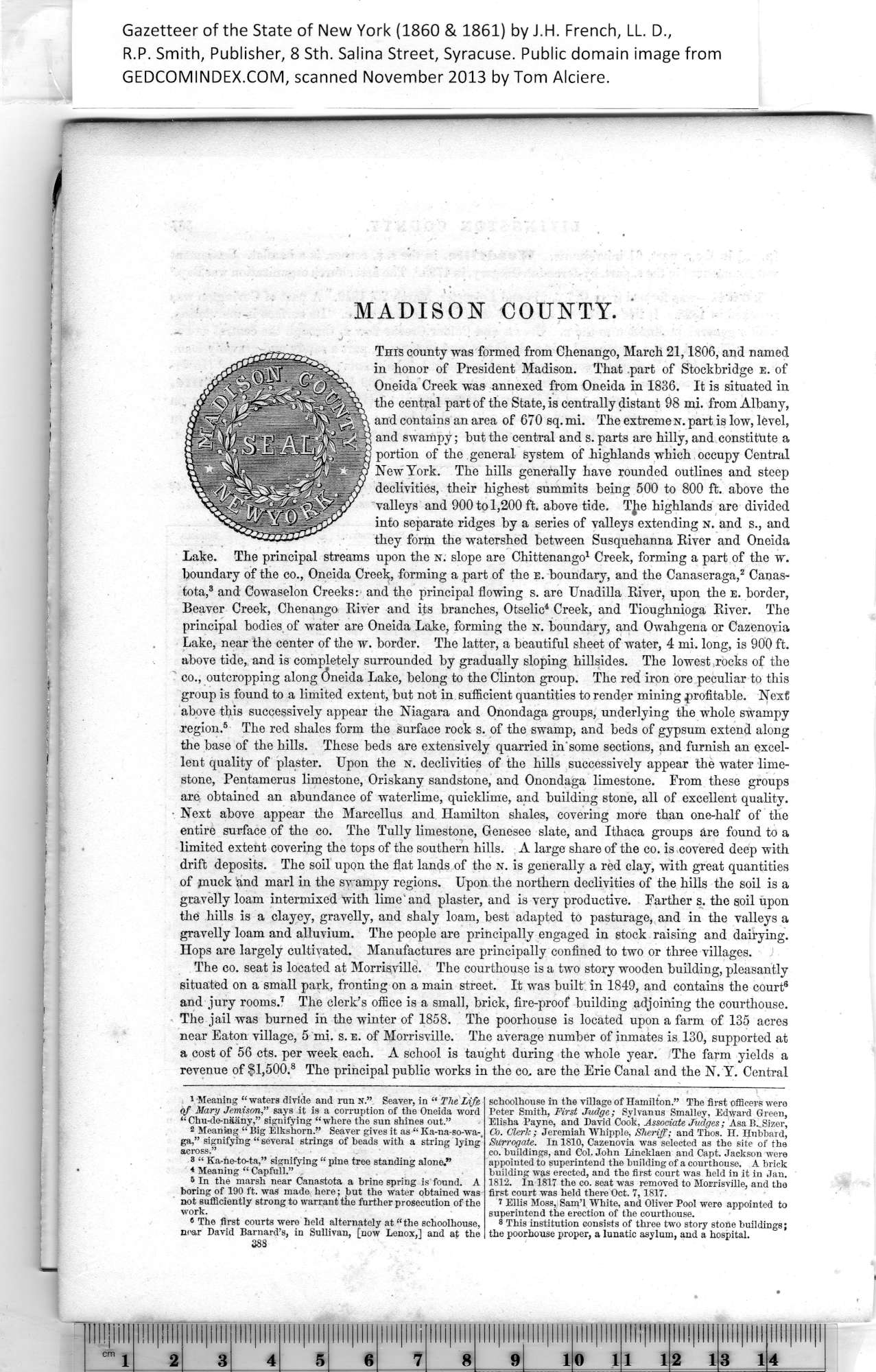|
i .
MADISON COUNTY. ’
This county was formed from Chenango, March 21,1806, and named
in honor of President Madison. That part of Stockbridge e. of
Oneida Creek was annexed from Oneida in 1836. It is situated in
the central part of the State, is centrally distant 98 mi. from Albany,
and contains an area of 670 sq. mi. The extreme n. part is low, level,
and swampy; but the central and s. parts are hilly, and constitute a
portion of the general system of highlands which occupy Central
New York. The hills generally have rounded outlines and steep
declivities, their highest summits being 500 to 800 ft. above the
valleys and 900 to 1,200 ft. above tide. TJie highlands are divided
into separate ridges by a series of valleys extending n. and s., and
they form the watershed between Susquehanna River and Oneida
Lake. The principal streams upon the n. slope are Chittenango1 Creek, forming a part of the w.
boundary of the co., Oneida Creek, forming a part of the e. boundary, and the Canaseraga,2 Canas-
tota,3 and Cowaselon Creeks: and the principal flowing s. are Unadilla River, upon the e. border,
Beaver Creek, Chenango River and its branches, Otselic4 Creek, and Tioughnioga River. The
principal bodies of water are Oneida Lake, forming the n. boundary, and Owahgena or Cazenovia
Lake, near the center of the w. border. The latter, a beautiful sheet of water, 4 mi. long, is 900 ft.
above tide, and is completely surrounded by gradually sloping hillsides. The lowest,rocks of the
co., outcropping along (5neida Lake, belong to the Clinton group. The red iron ore peculiar to this
group is found to a limited extent, but not in sufficient quantities to render mining profitable. Next
above this successively appear the Niagara and Onondaga groups, underlying the whole swampy
region.® The red shales form the surface rock s. of the swamp, and beds of gypsum extend along
the base of the hills. These beds are extensively quarried in'some sections, and furnish an excel¬
lent quality of plaster. Upon the n. declivities of the hills successively appear the water lime¬
stone, Pentamerus limestone, Oriskany sandstone, and Onondaga limestone. From these groups
are obtained an abundance of waterlime, quicklime, and building stone, all of excellent quality.
Next above appear the Marcellus and Hamilton shales, covering more than one-half of the
entire surface of the co. The Tully limestone, Genesee slate, and Ithaca groups are found to a
limited extent covering the tops of the southern hills. A large share of the co. is covered deep with
drift deposits. The soil upon the flat lands of the n. is generally a red clay, with great quantities
of muck and marl in the swampy regions. Upon the northern declivities of the hills the soil is a
gravelly loam intermixed with lime'and plaster, and is very productive. Farther s. the soil upon
the hills is a clayey, gravelly, and shaly loam, best adapted to pasturage, and in the valleys a
gravelly loam and alluvium. The people are principally engaged in stock raising and dairying.
Hops are largely cultivated. Manufactures are principally confined to two or three villages. J
The co. seat is located at Morrisville. The courthouse is a two story wooden building, pleasantly
situated on a small park, fronting on a main street. It was built in 1849, and contains the court6
and jury rooms.7 The clerk's office is a small, brick, fire-proof building adjoining the courthouse.
The jail was burned in the winter of 1858. The poorhouse is located upon a farm of 135 acres
near Eaton village, 5 mi. s. e. of Morrisville. The average number of inmates is 130, supported at
a cost of 56 cts. per week each. A school is taught during the whole year. The farm yields a
revenue of $1,500.® The principal public works in the co. are the Erie Canal and the N. Y. Central
|
* Meaning “waters divide and run N.” Seaver, in “ The Life
of Mary Jemison,” says it is a corruption of the Oneida word
“ Chu-de-naany,” signifying “where the sun shines out.”
2 Meaning “ Big Elkshorn.” Seaver gives it as “ Ka-na-so-wa-.
ga,” signifying “ several strings of heads with a string lying"
across.”
* “ Ka-he-to-ta,” signifying “ pine tree standing alone.”
* Meaning “ Capfull.”
6 In the marsh near Canastota a brine spring is found. A
boring of 190 ft. was made here; but the water obtained was
not sufficiently strong to warrant the further prosecution of the
work.
® The first courts were held alternately at “the schoolhouse,
near David Barnard’s, in Sullivan, [now Lenox,] and at the
m |
schoolhouse in the village of Hamilton.” The first officers were
Peter Smith, First Judge; Sylvanus Smalley, Edward Green,
Elisha Payne, and David Cook, Associate Judges; Asa IS._ Sizer,
Co. Clerk; Jeremiah Whipple, Sheriff; and Thos. H. Hubbard,
Surrogate. In 1810, Cazenovia was selected as the site of the
co. buildings, and Col. John Lincklaen and Capt. Jackson were
appointed to superintend the building of a courthouse. A brick
building was erected, and the first court was held in it in Jan.
1812. In 1817 the co. seat was removed to Morrisville, and the
first court was held there Oct. 7,1817.
i Ellis Moss, Sam’l White, and Oliver Pool were appointed to
superintend the erection of the courthouse.
8 This institution consists of three two story stone buildings;
the poorhouse proper, a lunatic asylum, and a hospital. |
|
